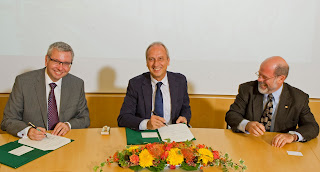The University of British Columbia today forged a formal partnership with the Max Planck Society, Germany's foremost basic research institution and home to 32 Nobel prizes.
UBC President Stephen Toope and Max Planck Society President Peter Gruss were joined in Munich today by Thomas Marr, Germany's Minister-Counsellor of Commercial and Economic Affairs, for the signing of a memorandum of understanding (MOU) that will establish the Max Planck-UBC Centre for Quantum Materials.
The agreement also commits both institutions to conducting joint research projects in Canada and Germany, and to increasing scholarly exchanges.
"Today's agreement represents a joining of great strengths within both the Max Plank Society and UBC and will provide the underpinning for future research in advanced materials science," said Prof. Toope. "The knowledge and discoveries generated from these collaborations will profoundly change the lives of present and future generations."
The Max Planck-UBC Centre for Quantum Materials is only the third Max Planck Center to be established. The others are the Indo Max Planck Center for Computer Science in India and the CSIC-MPG Research Unit in Spain, which focuses on early European culture and religion. The first and only Max Planck Institute in North America is in Florida with Florida Atlantic University and is currently under construction.
UBC is world renowned for research excellence in quantum materials – including superconductors – with potential applications in lossless power lines, vast improvements in computers and wireless communications, new advances in solar and fuel cells and a new class of medical electronic devices to aid diagnosis and treatment. To date, four Canada Research Chairs (CRC) in the area of condensed matter physics have been awarded to researchers at UBC, more than any other university in the country.
UBC principal investigators to lead research groups in the new Max Planck-UBC Centre include four CRC's and five Fellows of the Royal Society of Canada ¬¬– two of whom are also fellows of the Royal Society of London. In addition, three of the researchers are among the 100 most cited physicists in the world. They will be led by Prof. George Sawatzky, Canada Research Chair in Physics and Chemistry of Nano-structured Materials.
"The partnership with Max Planck is a testament to the caliber of research conducted here, and our researchers enjoy reputations as some of the most internationally collaborative in the world," said John Hepburn, UBC Vice President Research and International, who added that 46 per cent of UBC research is published jointly with colleagues outside Canada.
"Our interdisciplinary research strengths are further complemented by state-of-the-art facilities such as UBC's Advanced Materials and Process Engineering Laboratory, our vicinity to TRIUMF, Canada's National Laboratory for Particle and Nuclear Physics, and priority access to the Canadian Light Source Synchrotron."
Over the past 50 years, engineers have succeeded in developing smaller combinations of semiconductors, insulators and metals arranged to function as electronic devices while maintaining their fundamental electronic properties. Scientists at the forefront of advanced materials research are investigating the dramatic changes in properties that occur when such devices dive below current size limitations. ###
Contact: Brian Lin brian.lin@ubc.ca 604-822-2234 University of British Columbia















No comments:
Post a Comment